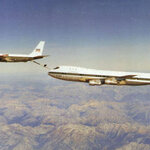Aerospace

NASA has released data showing how temperature and rainfall patterns worldwide may change through the year 2100 because of growing concentrations of greenhouse gases in Earth's atmosphere.
The dataset shows projected changes worldwide on a regional level in response to different scenarios of increasing carbon dioxide simulated by 21 climate models. The high-resolution data, which can be viewed on a daily timescale at the scale of individual cities and towns, will help scientists and planners conduct climate risk assessments to better understand local and global effects of hazards, such as…

Do microbes grow differently on the International Space Station than they do on Earth? Results from the growth of microbes collected by citizen scientists as part of Project MERCCURI indicate that most behave similarly in both places - and that is a good news for space travel.
Thousands of people across the country participated in the citizen science portion of the project, gathering samples from built environments such as chairs, doors, railings... even the Liberty Bell. Then a microbiology team led by David Coil, project scientist in the microbiology lab of Jonathan Eisen at the University…

MarsPolar, a newly started international venture, is setting its sights on the Red Planet.
The project, consisting of specialists from Russia, United Arab Emirates, Poland, U.S. and Ukraine, has come up with a bold idea to establish a human settlement on Mars’ polar region, the part of the planet with abundant quantities of water ice. The targeted area could be very interesting in terms of alien life hunting as the MarsPolar team puts it: “life begins where the water exists.”
The plan is to create the colony around 2029. “We want to send to Mars a crew of 4-6 astronauts, every 2 years,”…

New data from the spacecraft that orbited Mercury for four years before crashing into the planet a week ago reveals Mercury's magnetic field is almost four billion years old. The discovery helps scientists piece together the history of Mercury, the closest planet to the sun and one about which we knew very little before MESSENGER.
NASA's MESSENGER probe left Earth in 2004, reached Mercury in 2008 and has orbited the planet since 2011, sending data back . Researchers used data obtained by MESSENGER in the fall of 2014 and 2015 when the probe flew incredibly close to the planet's…

On March 17th, 2013, an object the size of a boulder hit the lunar surface in Mare Imbrium and exploded in a flash of light nearly 10 times as bright as anything ever recorded before - the largest recorded explosion occurred on the surface of the moon.
This bright flash was recorded at coordinates 20.6°N, 336.1°E and now Lunar Reconnaissance Camera (LROC) scientists have observations before and after the impact. LROC’s first set of post-impact flash images acquired on May 21, 2013 by the Narrow Angle Camera (NAC) were targeted on the coordinates and numerous small surface disturbances (“…

The Hubble Space Telescope is almost old enough to buy its own health insurance!
Tomorrow, April 24th, the Hubble Space Telescope will turn 25. For much of that time, it has been a few hundred miles away, providing a peek into the cosmos. It has long exceeded its mission life (good thing too, it's successor will be a decade past its original completion date and 900% over budget, if it even goes up on the latest 2018 date) but that is okay, Hubble shows no signs of letting up.
To celebrate its 25th birthday, we get an image of Westerlund 2, a giant cluster of about 3,000 stars which…
With the 25th anniversary of the Hubble Space Telescope next week, people are again thinking about its big successor. The very first month that this part of Science 2.0, the communications portal, went live, in January of 2007, we had an update on the James Webb Space Telescope and it was already way behind schedule.
In early 2010, when President Obama canceled the Constellation program, America's return to the moon, because it was 'too expensive', the assumption was that he was just playing politics. The Constellation project had the name of President George W. Bush on it while a new…

A remote gas planet has been detected about 13,000 light-years away, making it one of the most distant planets known.
The Poland-based Optical Gravitational Lensing Experiment (OGLE) Warsaw Telescope at the Las Campanas Observatory in Chile scans the skies for planets using a method called microlensing. A microlensing event occurs when one star happens to pass in front of another, and its gravity acts as a lens to magnify and brighten the more distant star's light. If that foreground star happens to be orbited by a planet, the planet might cause a blip in the magnification. For a new…

There’s real pressure on the aviation industry to introduce faster, cheaper and greener aircraft, while maintaining the high safety standards demanded of airlines worldwide.
Airlines carry more than three billion passengers each year, which presents an enormous challenge not only for aircraft manufacturers but for the civil aviation infrastructure that makes this extraordinary annual mass-migration possible. Many international airports are close to or already at capacity. The International Air Transport Association (IATA) has estimated that, without intervention, many global airports –…

Space is exciting so it is easy to get sucked into bold claims.
A few years ago one of our writers had the idea to launch Bloggy into space. He was going to do all the work and just needed the money to pay the company, Interorbital, a very reasonable-sounding amount, so it was on.
My only real question was, "The knock on these guys is that they keep cashing checks but they never actually launch anything. What makes you think they will this time?"
Bloggy in spaaaaace.
Well, he had no answer for that and it was more rhetorical than anything, no one can predict the future, but he was doing…